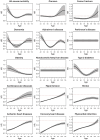The association of a polygenic lifespan score with the risk of common age-related diseases and mortality
- PMID: 40680229
- PMCID: PMC12380463
- DOI: 10.1093/gerona/glaf156
The association of a polygenic lifespan score with the risk of common age-related diseases and mortality
Abstract
Background: Aging increases the risk of major noncommunicable diseases. Research into the genetics of health-related traits could reveal genetic pathways for robustness against these diseases. We studied how a genetic predisposition for a long lifespan is associated with the risk of all-cause mortality and major age-related noncommunicable diseases.
Methods: We analyzed data from 376 753 participants (mean age = 58.5 years; standard deviation = 13.9 years; 46.3% men) to examine how a polygenic lifespan score (PLS) is associated with the risk of all-cause mortality and major noncommunicable diseases. The associations between all-cause mortality, cancers, femur fracture, dementia, Alzheimer's disease, Parkinson's disease, type 2 diabetes, obesity, cardiovascular diseases, hypertension, ischemic heart diseases, coronary heart disease, stroke, and myocardial infarction were investigated using conventional and time-dependent Cox regression.
Results: The PLS was associated with all the above-mentioned outcomes except for Parkinson's disease. Most of the associations were time-dependent, and the hazard ratio (HR) varied over time from protective to risk-increasing. However, the current PLS predicted noncommunicable disease risks with small effect sizes (lowest HR ≈ 0.70, highest HR ≈ 1.20, Cox-Snell pseudo-R2 > 0.01).
Conclusions: Genetic predisposition for a longer lifespan was associated with a smaller risk of common age-related noncommunicable diseases, suggesting greater robustness against these conditions. The lowest risks were found during periods when the incidences of diseases were greatest. The observed small effects highlight the need to better understand how accumulated environmental factors modify individual lifespans.
Keywords: FinnGen; genetic predisposition; noncommunicable diseases; time-dependent Cox regression.
© The Author(s) 2025. Published by Oxford University Press on behalf of the Gerontological Society of America.
Conflict of interest statement
None declared.
Figures



Similar articles
-
Dietary Approaches to Stop Hypertension (DASH) for the primary and secondary prevention of cardiovascular diseases.Cochrane Database Syst Rev. 2025 May 6;5(5):CD013729. doi: 10.1002/14651858.CD013729.pub2. Cochrane Database Syst Rev. 2025. PMID: 40326569 Review.
-
Beta-blockers in patients without heart failure after myocardial infarction.Cochrane Database Syst Rev. 2021 Nov 5;11(11):CD012565. doi: 10.1002/14651858.CD012565.pub2. Cochrane Database Syst Rev. 2021. PMID: 34739733 Free PMC article.
-
Prescription of Controlled Substances: Benefits and Risks.2025 Jul 6. In: StatPearls [Internet]. Treasure Island (FL): StatPearls Publishing; 2025 Jan–. 2025 Jul 6. In: StatPearls [Internet]. Treasure Island (FL): StatPearls Publishing; 2025 Jan–. PMID: 30726003 Free Books & Documents.
-
Effects of a gluten-reduced or gluten-free diet for the primary prevention of cardiovascular disease.Cochrane Database Syst Rev. 2022 Feb 24;2(2):CD013556. doi: 10.1002/14651858.CD013556.pub2. Cochrane Database Syst Rev. 2022. PMID: 35199850 Free PMC article.
-
Comparison of Two Modern Survival Prediction Tools, SORG-MLA and METSSS, in Patients With Symptomatic Long-bone Metastases Who Underwent Local Treatment With Surgery Followed by Radiotherapy and With Radiotherapy Alone.Clin Orthop Relat Res. 2024 Dec 1;482(12):2193-2208. doi: 10.1097/CORR.0000000000003185. Epub 2024 Jul 23. Clin Orthop Relat Res. 2024. PMID: 39051924
References
MeSH terms
Grants and funding
LinkOut - more resources
Full Text Sources

